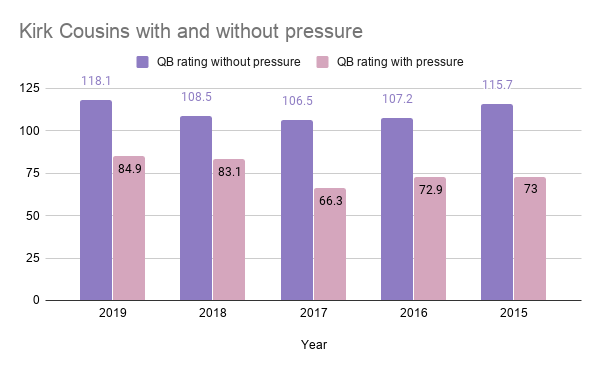Post by Purple Pain on Aug 1, 2020 10:46:29 GMT -6
The sky may be the limit for a proven offensive mind like Kubiak and quarterback in Cousins who has consistently put up strong numbers throughout his career. However, there are some signs that they will need to be a better offense in 2020 in order to achieve the same results.
Justin Jefferson may be a very exciting prospect but Stefon Diggs’s contributions will be missed. The Athletic notes that the Vikings were the fourth best team in the NFL in Expected Points Added versus man coverage, which speaks to Diggs’s incredible ability to separate from defensive backs. Diggs also led the NFL in deep passing yards.
Dalvin Cook can definitely continue to be good at running away from defenders on screens but being the best screen pass team in the NFL again won’t be easy.
They also tied for the most games against opponents that did not make the playoffs with 11. In games against non-playoff teams, Cousins had a 119.1 quarterback rating, second best against non-playoff teams in the NFL. In five games against playoff teams, his rating was 86.4 (15th).
So what changes can the Vikings make to stave off regression?
Picking the right offensive line combination is a big deal. Cousins’s QB rating dropped from 114.0 when kept clean to 84.9 (per PFF) last year when he was under pressure. And that was the best mark of his career. Throughout his starting career, Cousins’s under pressure rating has been as low as 66.3 (2017). If he is pressured just as much as 2019 (10th highest percentage of pressured drop backs), the Vikings’ QB is likely to have worse results.

Whether less pressure can be achieved or not with the Vikings’ new-look offensive line is hard to say (especially since we don’t know the starting five) but one thing they should take into consideration is the best possible group for pass protection. Last year guard Pat Elflein was the second least efficient pass blocker among all players at his position but graded as the 12th best run blocker. As Cousins’s numbers indicate, it’s worth losing a little in the run game to improve any amount in pass protection.
Justin Jefferson may be a very exciting prospect but Stefon Diggs’s contributions will be missed. The Athletic notes that the Vikings were the fourth best team in the NFL in Expected Points Added versus man coverage, which speaks to Diggs’s incredible ability to separate from defensive backs. Diggs also led the NFL in deep passing yards.
Dalvin Cook can definitely continue to be good at running away from defenders on screens but being the best screen pass team in the NFL again won’t be easy.
They also tied for the most games against opponents that did not make the playoffs with 11. In games against non-playoff teams, Cousins had a 119.1 quarterback rating, second best against non-playoff teams in the NFL. In five games against playoff teams, his rating was 86.4 (15th).
So what changes can the Vikings make to stave off regression?
Picking the right offensive line combination is a big deal. Cousins’s QB rating dropped from 114.0 when kept clean to 84.9 (per PFF) last year when he was under pressure. And that was the best mark of his career. Throughout his starting career, Cousins’s under pressure rating has been as low as 66.3 (2017). If he is pressured just as much as 2019 (10th highest percentage of pressured drop backs), the Vikings’ QB is likely to have worse results.

Whether less pressure can be achieved or not with the Vikings’ new-look offensive line is hard to say (especially since we don’t know the starting five) but one thing they should take into consideration is the best possible group for pass protection. Last year guard Pat Elflein was the second least efficient pass blocker among all players at his position but graded as the 12th best run blocker. As Cousins’s numbers indicate, it’s worth losing a little in the run game to improve any amount in pass protection.
purpleinsider.substack.com/p/the-vikings-offense-isnt-expected





















 ... and neither is this Chris guy.
... and neither is this Chris guy.